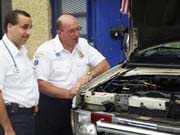McGyver, the 1980s hit television hero known for successfully fighting the bad guys with woefully few resources, would have fit right in at the Hoboken Volunteer Ambulance Corps. Like the action hero who once rebuilt an entire car using only a screwdriver and his smarts, the corps has had to make the most of what little it has since it was first founded in 1971.
Today the 88-member volunteer corps, which is the last all-volunteer ambulance corps in Hudson County, responds to more than 4,000 calls a year on an annual operating budget of $128,000. Its funding is provided through a combination of city grants and private donations.
While officers with the corps proudly point out that in the last two years they have almost never missed a call, they also say that they simply need more money to continue to provide residents with high-quality emergency services.
Thomas Molta, the president of the corps, says that the service is so cash-strapped that corps members frequently have to dip into their own pockets to cover expenses.
While this may help the ambulance workers meet their day-to-day needs, Molta says that more help is needed to ensure that the corps’ three ambulances remain operational.
“Our ambulances are literally held together with spit and glue,” said Molta on Monday. “The average life expectancy of an ambulance is five years and our newest vehicle is five years old. These things take a beating. They are always racing around, being driven by different people. Stop and go. Stop and go. Our other vehicles are a ’92 and a ’90.”
“The concern is that we may have to go down to two ambulances in the future,” he added. “That would mean that if two are deployed and we get a third call, there could be a delay.”
In the past, the firefighters have responded to emergency service calls when the volunteer corps was unable to respond.
In the next few months the corps plans to launch a fundraising drive intended to raise the $180,000 necessary to replace its two older vehicles. “Right now we are spending three times more on vehicle repair than we are spending on medical supplies,” said Molta. “The vehicles account for 69 percent of our budget.”
The corps president can tick off a string of reasons why an investment in better ambulances makes sense for the city and its residents. Chief among them is the quality of care that he says the volunteers provide. “We are here because we choose to be,” explained the president, who donned the corps’ blue uniform for the first time 20 years ago when he was 16. “We are not here for a paycheck. I think that translates indirectly into better patient care.”
It also saves the city between two and three million dollars a year, says Molta. Business Administrator George Crimmins said that he was impressed with the level of service the corps has been able to provide city residents in the last two years particularly, but he said that he was not sure the service saved the taxpayers so much money.
“We have looked at options of what we do if there were no volunteer service,” he explained. “Those duties would go to the fire service. There would be increased costs due to more personnel needs and a different pay salary.”
“But some of those costs would be offset by the fact that the city could bill third party insurance companies for services,” he added. “Since our service is volunteer they are prohibited from doing that. We have some estimates that once you take that billing into account that this could be something the city would break even on – or even make a few dollars.”
Crimmins estimated that the city spends about $125,000 a year on the service, since the city picks up the costs of fueling the ambulances and paying for the corps insurance, in addition to providing a $35,000 stipend.
While Molta said that the city has been “very generous” with the corps, he noted that the stipend has not been increased since 1983. Under state law, it could be bumped up to $70,000, he said.
A visit to the corps’ headquarters at Seventh and Clinton streets shows that the corps’ money problems are deep-seated. The building was purchased in 1973 by the corps for $14,000. And very little has been done to it since. An effort to build a bathroom on the first floor was abandoned for lack of funds. The partition that separates the men’s sleeping quarters from the women’s is temporary. The corps could not afford anything more. And the “lounge” where members relax while they wait for emergency calls is filled with the sort of second hand furniture most college students would be embarrassed to be caught with.
“Nothing here is new,” explained Lt. Willie Collins as he fluffed up a couch that looked like it needed more than just a fluffing up. “Everything came from somewhere else first.”
But despite the lack of luxury, an overwhelming pride in what they do is evident in the way that all the corps members talk about their volunteer work.
While they may not have a computer that boots up in less than an hour, they have worked together to convert an old school bus into a mobile field command unit that would allow them to deal with multiple injuries at the same site at one time.
“If people could see what we can pull off, they would be impressed,” said Collins. “Within a few moments, and a couple of beeps, we can get 30 or 40 corps members mobilized. A couple of beeps, a couple of calls and people will drop dinner and run out of the house to help. It’s pretty amazing.”
